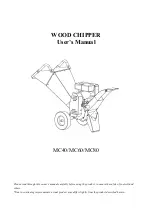
SERVICE INSTRUCTIONS
1.
Turn off the chipper and remove the key.
2.
Remove the negative battery lead.
3.
Turn the discharge tube to point across the
machine.
4.
Using a 24mm spanner remove the two M16
nuts clamping the rotor housing shut.
5.
Carefully lift the rotor housing until its rests on
its stop.
6.
Using the fan blades turn the rotor so the first
blade to be changed is in a convenient
position.
7.
Brush away all dirt and debris from the rotor
and blades.
8.
With a 24mm spanner undo the two nyloc nuts
that are holding the blade in place.
9.
Grasp the blade by the flat edges whilst
wearing heavy gloves.
10.
Withdraw the blade from the rotor.
11.
If the blades are being rotated and not
replaced, do not remove the blade bolts.
12.
If the blades are to be renewed, place the
blade on a flat surface and tap the top of
the blade bolts with a hammer. The bolts
are designed for this. They should loosen
from the blade. Withdraw them completely.
13.
Clean the blade pocket, blade seat and
blade bolts before reseating new blades.
The blades must not have any material
underneath them when tightened. If they
are not flat and tight they will become loose
quickly.
14.
Reassemble the blades and bolts in the
order they were removed.
15.
Apply a smear of anti seize compound to
the bolt threads.
16.
Tighten the bolts using a torque wrench to
135Nm or 100 lbs ft.
17.
Repeat this procedure for the other blade.
18.
Slowly lower the rotor housing to its original
position.
19.
Refit the two M16 nuts and tighten to
80Nm or 60 lbs ft.
WARNING
Wear heavy gloves for the blade changing operation.
CHANGE BLADES
!
!
15
WARNING
Always sharpen blades on a regular basis. Failure to do so will
cause the machine to under perform and will overload engine and
bearings causing machine breakdown. Blades must not be
sharpened beyond the wear mark (see diagram). Failure to comply
with this could result in machine damage, injury or loss of life.
4
5
6
8
10
THIS PROCEDURE SHOULD ONLY BE UNDERTAKEN WITH THE DISCHARGE IN PLACE.
fig 10.
fig 11.
fig 12.
!
!
WEAR
MARK
fig 13.
















































